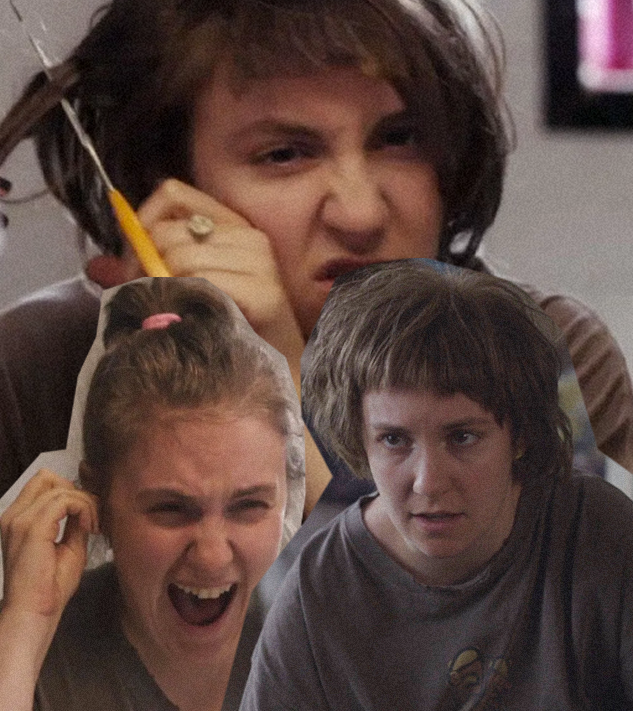Lena Dunham’s Girls and the Longevity of Unglamourising Mental Illness
Our culture has grown used to eating disorders and addictions and waifish depressions eating at our creatives, and the romanticisation of these problems tends to place them at the root of the artist’s success. The coquette aesthetic, Otessa Moshfegh’s My Year of Rest and Relaxation, and eating disorder Twitter all owe their success to this commodification of instability. From Susanna Kaysen to Effy Stonem, the glamourisation of the suffering girl has been an ongoing trend in the media we consume.
Lena Dunham has problems, too. Her vivid, performative self-hatred comes across in interviews, reviews, and most episodes of her series Girls, which ran on HBO for six seasons between 2012 and 2017. Throughout the show’s run, we see Hannah Horvath - Dunham’s semi-autobiographical avatar - wallow under the pressure of financial independence, pretend to experience grief when all she feels is emptiness, and perforate her eardrum with a Q-tip. Dunham paints mental illness as ugly, as something you’d want to avoid at all costs. Because of this, her work remains irreverent even as the millennial culture of her heyday inches its way out of popularity.
In reality, mental illness is not beautiful. It is bloody, it smells bad, and it attracts bugs. It creates a mess, and it destroys friendships. Asking for help isn’t just hard, but it can feel humiliating. This is the vision of poor mental health that Dunham creates in Girls. Each of the four main characters shows a different side of female mental illness; Hannah is a disaster. She claims to hate herself while having one of the biggest egos to grace the television screen. She lets her relationships rot and only puts in any work when she starts to feel sorry for herself. Her best friend Marnie Michaels is almost the complete opposite. At the beginning of the series, Marnie is seemingly happily coupled and employed. She feels confident until said relationship caves in and she falls apart, which leads her to seek relationships and artistic success that will (or won’t) fill the hole left behind.
___STEADY_PAYWALL___
“Although each character can be, at different points of the show, described as a horrible person, they are all deeply relatable.”
Jessa, a college friend of the two, is a reckless drug addict who attempts to cover up her unhappiness with a bohemian lifestyle but fails repeatedly. Her cousin, Shoshanna at first, perhaps, appears to be the most normal. Shosh, though, is ripped apart with insecurity about her twenty-one-year-old virginity and inexperience in life. While she enters the show less messily than the other three, her innocence and desire for stability lead her away from her education and into the tumultuous lives of her three closest friends which she eventually removes herself from for her own sanity. Each of these characters experiences extreme highs and lows circumstantially and mentally, but they do so in wildly different ways, which is a large factor into what makes Girls so compelling.
A common practice of Girls fanatics is to debate which Girl one aligns oneself with. The podcast HBO Girls Rewatch introduces each guest by asking “Girl, which Girl are you.” Most times, the guest describes themselves through the archetypal box of one character: Hannah, riddled with shame and hubris. Marnie, teetering on the edge with a sheen of drive. Jessa, a reckless wild child. Or Shoshanna, quirky and innocent and earnest. At its core, this habit of assigning a Girl to oneself and debating their traits is why the show continues to hit so hard. A millennial personality quiz a la Sex and the City. Although each character can be, at different points of the show, described as a horrible person, they are all deeply relatable. Hannah, Marnie, Jessa, and Shosh are characters with their own depths and uniquenesses, and they represent archetypes for an entire generation - the four horsewomen of young adulthood, of messiness and internal turmoil.
The girls of Girls live in the New York City of the early 2010s, a time when Brooklyn is still out of the way and, according to Marnie, texting is one of the lowest forms of communication. The characters are all privileged in their own way and nearly all receive support from wealthier relatives at some point. The world the Girls live in becomes less and less relatable to the average watcher as time goes on and the class divide widens, but this bygone, inaccessible world is still romanticised by those fans of the show who will never experience it due to the authenticity of the show’s core characters.
Girls is so watchable and rewatchable because the characters do and experience so many awful things, but also because they live in a slightly fantastical alternate reality where the rent is always paid and jobs fall into your lap. The show is both nostalgic and representative of a rude awakening into adulthood but perhaps most importantly, it gracefully avoids the romanticisation of mental illness. Yes, Adam Driver is beautiful, but his problems remain problems on screen, without the sanitisation or idealisation that our culture tends to offer up in exchange for difficult emotions. To its young adult audience, Girls is relatable without being dangerous, which is rare in a culture that so glamorises suffering.
Words: Katie Stollmack


